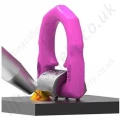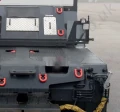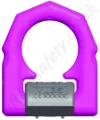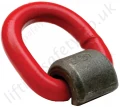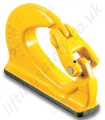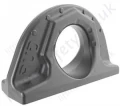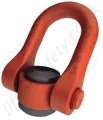- Lifting Equipment
-
Height Safety

Height Safety Equipment
- Material Handling & Jacking Equipment
- Shop by Brand
- Clearance
-
Contact
Get In Touch
- Home/
- Lifting Equipment/
- General Industrial Lifting Equipment/
- Weld-on Lifting Eyes and Lashing Points/
- Weld-on “Swivel” Lifting Eyes and Welded Down Lashing Points/
- RUD "VLBS" & "VLBSU" Weld On Load Rings
Load Ring VLBS-U with spring
- Range from 1500kg to 16,000kg.
- Suspension ring & weld-on-block of the VLBS-U are undetachable.
- Suspension ring can be angled into position.
- 4:1 Safety Factor.
- Full working load in all directions.
- DGUV approval.
- 180° pivoting range.
- Suspension ring can be angled into position (VLBS-U).
- Max. operation temperature range WITHOUT reduction in WLL -20°-200°C.
- Max. operation temperature range WITH reduction in WLL 400°C.
Load Ring VLBS without spring
- Range from 1500kg to 16,000kg.
- Supplied WITHOUT clamping spring so the link swivels / lays freely with no resistance.
- Suspension ring & weld-on-block of the VLBS are detachable
- 4:1 Safety Factor.
- Full working load in all directions.
- DGUV approval.
- 180° pivoting range.
- Max. operation temperature range WITHOUT reduction in WLL -20°-200°C.
- Max. operation temperature range WITH reduction in WLL 400°C.
Dimensions & Specifications
| Type | WLL (t) | Weight (kg) | A | B | C | D | E | F | T |
| VLBS 1.5t | 1.5 | 0.35 | 33 | 66 | 38 | 25 | 40 | 14 | 65 |
| VLBS 2.5t | 2.5 | 0.47 | 36 | 77 | 45 | 27 | 48 | 16 | 75 |
| VLBS 2.5t* | 2.5 | 0.48 | 38 | 77 | 45 | 28 | 47 | 16 | 75 |
| VLBS 4t | 4 | 0.8 | 42 | 87 | 51 | 31 | 52 | 18 | 83 |
| VLBS 6.7t | 6.7 | 1.9 | 61 | 115 | 67 | 44 | 73 | 24 | 117 |
| VLBS 10t | 10 | 2.9 | 75 | 129 | 67 | 55 | 71 | 26.5 | 126 |
| VLBS 16t* | 16 | 7.12 | 95 | 192 | 100 | 69 | 106 | 40 | 176 |
*Will be supplied as new octagonal shape.
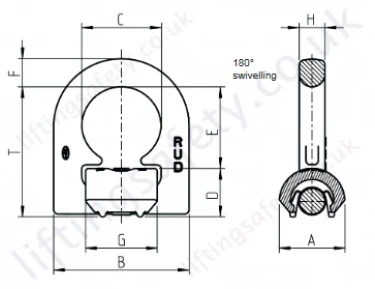
Metric Capacities - Table 1
| Method of lift |  |
 |
 |
 |
 |
 |
 |
 |
|||
| Number of legs | 1 | 1 | 2 | 2 | 2 | 2 | 2 | 3 and 4 | 3 and 4 | 3 and 4 | |
| Angle of inclination < ß | 0° | 90° | 0° | 90° | 0-45° | 45-60° | unsymmetrical | 0-45° | 45-60° | unsymmetrical | |
| Factor | 1 | 1 | 2 | 2 | 1.4 | 1 | 1 | 2.1 | 1.5 | 1 | |
| Metric Type | WLL in metric tonnes | ||||||||||
| VLBS 1.5t | 1.5t | 1.5t | 3t | 3t | 2.1t | 1.5t | 1.5t | 3.15t | 2.25t | 1.5t | |
| VLBS 2.5t | 2.5t | 2.5t | 5t | 5t | 3.5t | 2.5t | 2.5t | 5.25t | 3.75t | 2.5t | |
| VLBS 4t | 4t | 4t | 8t | 8t | 5.6t | 4t | 4t | 8.4t | 6t | 4t | |
| VLBS 6.7t | 6.7t | 6.7t | 13.4t | 13.4t | 9.5t | 6.7t | 6.7t | 14t | 10t | 6.7t | |
| VLBS 10t | 10t | 10t | 20t | 20t | 14.0t | 10t | 10t | 21t | 15t | 10t | |
| VLBS 16t | 16t | 16t | 32t | 32t | 22.4t | 16t | 16t | 33.6t | 24t | 16t | |
User Instructions
1. Reference should be made to German Standards accord.
BGR 500 or other country specific statutory regulations and inspections are to be carried out by competent persons only.
2. Before installing and every use, visually inspect RUD lifting points, paying particular attention to any evidence of weld cracks, corrosion, wear, deformations, etc.
3. The material construction to which the lifting point will be attached should be of adequate strength to withstand forces during lifting without deformation. The contact areas must be free from inpurities, oil, colour, ect.
The material of the forged welding block is S355J2+N (St52-3, 1.0577+N), B.S. 4360.50 D or AISI 1019
4. The lifting points must be positioned on the load in such a way that movement is avoided during lifting.
a.) For single leg lifts, the lifting point should be vertically above the centre of gravity of the load.
b.) For two leg lifts, the lifting points must be equidistant to/or above the centre of gravity of the load.
c.) For three and four leg lifts, the lifting points should be arranged symmetrically around the centre of gravity in the same plane.
5. Load Symmetry:
The working load limits of individual RUD lifting points are calculated using the following formula and are based on symmetrical loading:
|
WLL =
|
G n x cos ß |
WLL = Working Load Limit G = Load Weight (kg) n = Number of load bearing legs ß = Angle of inclination of the chain to the vertical |
The calculation of load bearing legs is as follows:
| No. Legs | Symmectrical | Asymmetrical |
| Two Leg | 2 | 1 |
| Three / Four Leg | 3 | 2 |
(See Table 1 and 5)
6. All fittings connected to the VLBS should be free moving.
When connecting and disconnecting the lifting means (sling chain) pinches and impacts should be avoided. Damage of the lifting means caused by sharp edges should be avoided as well.
7. The complete design can be annealed stress-free several times up to <600°C (1100°F) without reduction of WLL.
8. The places where the lifting points are fixed should be marked with colour.
9. At outdoor sites or in case of special danger of corrosion, the welds should only be designed as continuous, fillet welds.
The HV weld at the VLBS guarantees a connection via the whole cross section of the material. This corresponds to a closed weld showing no signs of corrosion.
10. The distance lugs assist in achieving the correct root weld (approx. 3 mm = 0.1 inch). They may not be removed.
11. If the lifting points are used exclusively for lashing the value of the working load limit can be doubled. LC = 2 x WLL
12. After welding, an annual inspection or sooner if conditions dictate should be undertaken by a competent person examining the continued suitability. Also after damage and special occurrences.
Inspection criteria concerning paragraphs 2 and 12:
- The lifting point should be complete.
- The working load limit and manufacturers stamp should be clearly visible.
- Deformation of the component parts such as body and load ring.
- Mechanical damage, such as notches, particulary in high stress areas.
- Wear should be no more than 10% of cross sectional diameter.
- Evidence of corrosion.
- Evidence of cracks.
- Cracks or other damages to the welding.
A non-adherence to this advice may result damages of persons and materials !
Welding sequence:
The welding should only be carried out according to EN 287 or AWS Standards by an authorized welder.
- Start of the root welding has to be in the center of the welding block.
- Before carrying out the top run, carefully clean the root.
- The welding process must not be interrupted for such a time that the welding block loses the welding temperature.
- Attention: Do not weld at the pink powder coated, heat treated load ring.
Welding Seam Definition - Table 2
| Welding Seam Definition | Model | Size | Length | Volume |
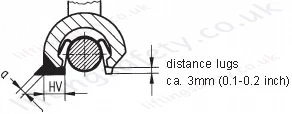 |
VLBS 1,5 t | HV 5 + a 3 |
2 x 33 mm | ca. 1,2 cm³ |
| VLBS 2,5 t | HV 7 + a 3 |
2 x 40 mm | ca. 2,6 cm³ | |
| VLBS 4 t | HV 8 + a 3 |
2 x 46 mm | ca. 3,2 cm³ | |
| VLBS 6,7 t | HV 12 + a 4 |
2 x 60 mm | ca. 8,7 cm³ | |
| VLBS 10 t | HV 16 + a 4 |
2 x 60 mm | ca. 15,5 cm³ | |
| VLBS 16 t | HV 25 + a 6 |
2 x 90 mm | ca. 56 cm³ |
Pricing
Availability
Usually 1-2 Working Days - 1pm cut-off
Load Ring VLBS-U with spring
- Range from 1500kg to 16,000kg.
- Suspension ring & weld-on-block of the VLBS-U are undetachable.
- Suspension ring can be angled into position.
- 4:1 Safety Factor.
- Full working load in all directions.
- DGUV approval.
- 180° pivoting range.
- Suspension ring can be angled into position (VLBS-U).
- Max. operation temperature range WITHOUT reduction in WLL -20°-200°C.
- Max. operation temperature range WITH reduction in WLL 400°C.
Load Ring VLBS without spring
- Range from 1500kg to 16,000kg.
- Supplied WITHOUT clamping spring so the link swivels / lays freely with no resistance.
- Suspension ring & weld-on-block of the VLBS are detachable
- 4:1 Safety Factor.
- Full working load in all directions.
- DGUV approval.
- 180° pivoting range.
- Max. operation temperature range WITHOUT reduction in WLL -20°-200°C.
- Max. operation temperature range WITH reduction in WLL 400°C.
Dimensions & Specifications
| Type | WLL (t) | Weight (kg) | A | B | C | D | E | F | T |
| VLBS 1.5t | 1.5 | 0.35 | 33 | 66 | 38 | 25 | 40 | 14 | 65 |
| VLBS 2.5t | 2.5 | 0.47 | 36 | 77 | 45 | 27 | 48 | 16 | 75 |
| VLBS 2.5t* | 2.5 | 0.48 | 38 | 77 | 45 | 28 | 47 | 16 | 75 |
| VLBS 4t | 4 | 0.8 | 42 | 87 | 51 | 31 | 52 | 18 | 83 |
| VLBS 6.7t | 6.7 | 1.9 | 61 | 115 | 67 | 44 | 73 | 24 | 117 |
| VLBS 10t | 10 | 2.9 | 75 | 129 | 67 | 55 | 71 | 26.5 | 126 |
| VLBS 16t* | 16 | 7.12 | 95 | 192 | 100 | 69 | 106 | 40 | 176 |
*Will be supplied as new octagonal shape.

Metric Capacities - Table 1
| Method of lift |  |
 |
 |
 |
 |
 |
 |
 |
|||
| Number of legs | 1 | 1 | 2 | 2 | 2 | 2 | 2 | 3 and 4 | 3 and 4 | 3 and 4 | |
| Angle of inclination < ß | 0° | 90° | 0° | 90° | 0-45° | 45-60° | unsymmetrical | 0-45° | 45-60° | unsymmetrical | |
| Factor | 1 | 1 | 2 | 2 | 1.4 | 1 | 1 | 2.1 | 1.5 | 1 | |
| Metric Type | WLL in metric tonnes | ||||||||||
| VLBS 1.5t | 1.5t | 1.5t | 3t | 3t | 2.1t | 1.5t | 1.5t | 3.15t | 2.25t | 1.5t | |
| VLBS 2.5t | 2.5t | 2.5t | 5t | 5t | 3.5t | 2.5t | 2.5t | 5.25t | 3.75t | 2.5t | |
| VLBS 4t | 4t | 4t | 8t | 8t | 5.6t | 4t | 4t | 8.4t | 6t | 4t | |
| VLBS 6.7t | 6.7t | 6.7t | 13.4t | 13.4t | 9.5t | 6.7t | 6.7t | 14t | 10t | 6.7t | |
| VLBS 10t | 10t | 10t | 20t | 20t | 14.0t | 10t | 10t | 21t | 15t | 10t | |
| VLBS 16t | 16t | 16t | 32t | 32t | 22.4t | 16t | 16t | 33.6t | 24t | 16t | |
User Instructions
1. Reference should be made to German Standards accord.
BGR 500 or other country specific statutory regulations and inspections are to be carried out by competent persons only.
2. Before installing and every use, visually inspect RUD lifting points, paying particular attention to any evidence of weld cracks, corrosion, wear, deformations, etc.
3. The material construction to which the lifting point will be attached should be of adequate strength to withstand forces during lifting without deformation. The contact areas must be free from inpurities, oil, colour, ect.
The material of the forged welding block is S355J2+N (St52-3, 1.0577+N), B.S. 4360.50 D or AISI 1019
4. The lifting points must be positioned on the load in such a way that movement is avoided during lifting.
a.) For single leg lifts, the lifting point should be vertically above the centre of gravity of the load.
b.) For two leg lifts, the lifting points must be equidistant to/or above the centre of gravity of the load.
c.) For three and four leg lifts, the lifting points should be arranged symmetrically around the centre of gravity in the same plane.
5. Load Symmetry:
The working load limits of individual RUD lifting points are calculated using the following formula and are based on symmetrical loading:
|
WLL =
|
G n x cos ß |
WLL = Working Load Limit G = Load Weight (kg) n = Number of load bearing legs ß = Angle of inclination of the chain to the vertical |
The calculation of load bearing legs is as follows:
| No. Legs | Symmectrical | Asymmetrical |
| Two Leg | 2 | 1 |
| Three / Four Leg | 3 | 2 |
(See Table 1 and 5)
6. All fittings connected to the VLBS should be free moving.
When connecting and disconnecting the lifting means (sling chain) pinches and impacts should be avoided. Damage of the lifting means caused by sharp edges should be avoided as well.
7. The complete design can be annealed stress-free several times up to <600°C (1100°F) without reduction of WLL.
8. The places where the lifting points are fixed should be marked with colour.
9. At outdoor sites or in case of special danger of corrosion, the welds should only be designed as continuous, fillet welds.
The HV weld at the VLBS guarantees a connection via the whole cross section of the material. This corresponds to a closed weld showing no signs of corrosion.
10. The distance lugs assist in achieving the correct root weld (approx. 3 mm = 0.1 inch). They may not be removed.
11. If the lifting points are used exclusively for lashing the value of the working load limit can be doubled. LC = 2 x WLL
12. After welding, an annual inspection or sooner if conditions dictate should be undertaken by a competent person examining the continued suitability. Also after damage and special occurrences.
Inspection criteria concerning paragraphs 2 and 12:
- The lifting point should be complete.
- The working load limit and manufacturers stamp should be clearly visible.
- Deformation of the component parts such as body and load ring.
- Mechanical damage, such as notches, particulary in high stress areas.
- Wear should be no more than 10% of cross sectional diameter.
- Evidence of corrosion.
- Evidence of cracks.
- Cracks or other damages to the welding.
A non-adherence to this advice may result damages of persons and materials !
Welding sequence:
The welding should only be carried out according to EN 287 or AWS Standards by an authorized welder.
- Start of the root welding has to be in the center of the welding block.
- Before carrying out the top run, carefully clean the root.
- The welding process must not be interrupted for such a time that the welding block loses the welding temperature.
- Attention: Do not weld at the pink powder coated, heat treated load ring.
Welding Seam Definition - Table 2
| Welding Seam Definition | Model | Size | Length | Volume |
 |
VLBS 1,5 t | HV 5 + a 3 |
2 x 33 mm | ca. 1,2 cm³ |
| VLBS 2,5 t | HV 7 + a 3 |
2 x 40 mm | ca. 2,6 cm³ | |
| VLBS 4 t | HV 8 + a 3 |
2 x 46 mm | ca. 3,2 cm³ | |
| VLBS 6,7 t | HV 12 + a 4 |
2 x 60 mm | ca. 8,7 cm³ | |
| VLBS 10 t | HV 16 + a 4 |
2 x 60 mm | ca. 15,5 cm³ | |
| VLBS 16 t | HV 25 + a 6 |
2 x 90 mm | ca. 56 cm³ |
You May Also Like
Contact Us About This Product
If you wish to receive a quote for this product, please use the tab above, this form is for general enquiries regarding this product only.
You can also Request a Quote using the Quote tab above!
You can easily add more than one item to the Quote Request. This is highly recommended as we will be able to suit your needs much more efficiently.
